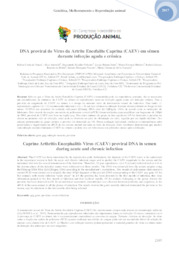DNA proviral do Vírus da Artrite Encefalite Caprina (CAEV) em sêmen durante infecção aguda e crônica.
DNA proviral do Vírus da Artrite Encefalite Caprina (CAEV) em sêmen durante infecção aguda e crônica.
Author(s): SOUZA, K. C.; ANDRIOLI, A.; PINHEIRO, R. R.; SIDER, L. H.; MARTINS, M. F.; MOTTA, I. G. B.; PEIXOTO, R. M.; TEIXEIRA, M. F. S.
Summary: Resumo: Sabe-se que o Vírus da Artrite Encefalite Caprina (CAEV) é transmitido pela via reprodutiva, portanto, faz-se necessário um entendimento da dinâmica do CAEV no sêmen de reprodutores tanto na infecção aguda como em infecção crônica. Para a previsão da magnitude do CAEV no sêmen e o tempo de máximo risco da transmissão sexual do lentivírus. Para tanto, 11 reprodutores caprinos (n = 5) recentemente infectados e (n = 6) em fase crônica da infecção tiveram sêmen coletado ao longo de três meses. O DNA das amostras foi extraído utilizando QIAamp DNA mini kit (QIAgen, USA) de acordo com as instruções do fabricante. Dois rounds da reação em cadeia da polimerase nested (nPCR) foram realizados para amplificar um fragmento de 185pb do DNA proviral do CAEV com base na região gag. Dos cinco animais do grupo na fase aguda em 4/5 foi detectado o provírus no sêmen no primeiro mês de infecção, onde pode-se observar um pico de eliminação do vírus, seguido por um rápido declínio. Dos animais pertencentes ao grupo crônico o provírus foi detectado em 4/6. Numa avaliação individual, verificou-se intermitência entre positividade e negatividade na nPCR de um mesmo animal em todas as fases da infecção. Estes resultados demonstram que machos com infecção recente eliminam o CAEV no sêmen e podem vir a ser infecciosos nos primeiros meses após a infecção. [Caprine Arthritis Encephalitis Virus (CAEV) proviral DNA in semen during acute and chronic infection]. Abstract: That CAEV has been transmitted by the reproductive path, furthermore, the dynamic of the CAEV needs to be understood in the reproducer semen in both the acute and chronic infection stages and to predict the CAEV magnitude in the semen and the maximum risk time for sexual transmission of the lentivirus. Therefore, 11 goat reproducers, (n = 5) recently infected and (n = 6) in the chronic phase of the infection semen were collected over three months. The DNA was extracted from the semen samples using the QIAamp DNA Mini Kit (QIAgen, USA) according to the manufacturer?s instructions. Two rounds of polymerase chain reaction (nested PCR) were carried out to amplify the final 185pb fragment of the proviral DNA corresponding to the CAEV gag gene. Of the five animals with recent infection ?acute phase? in 4/5 the provirus has been detected in the first month of infection, that virus elimination peaked in the first month of infection and then declined rapidly. Of the animals belonging to the group chronic the provirus has been detected in 4/6. In an individual assessment, intermittence was observed between positivity and negativity in the nPCR of the same animal in all the phases of infection. The results showed the goats recently infected eliminated the provirus in the semen, may be infectious in the first months after being infected.
Publication year: 2017
Types of publication: Paper in annals and proceedings
Unit: Embrapa Goats & Sheep
Observation
Some of Embrapa's publications are published as ePub files. To read them, use or download one of the following free software options to your computer or mobile device. Android: Google Play Books; IOS: iBooks; Windows and Linux: Calibre.
Access other publications
Access the Agricultural Research Database (BDPA) to consult Embrapa's full library collection and records.
Visit Embrapa Bookstore to purchase books and other publications sold by Embrapa.

